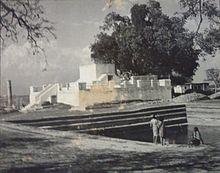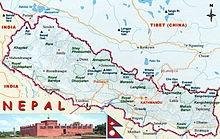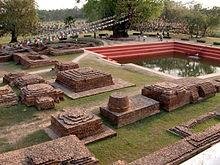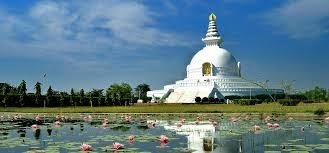Lumbini "Birth place of Siddhartha Gautam" ( Founder of Buddhism ) (Light of Asia )
 Lumbinī (Nepali and Sanskrit: लुम्बिनी About this sound listen , "the lovely") is a Buddhist pilgrimage site in the Rupandehi District of Nepal. It is the place where, according to Buddhist tradition, Queen Mayadevi gave birth to Siddhartha Gautama in 563 BCE.[1][2] Gautama, who achieved Enlightenment some time around 528 BCE,[3][4] became the Buddha and founded Buddhism.[5][6][7] Lumbini is one of many magnets for pilgrimage that sprang up in places pivotal to the life of the Buddha.
Lumbinī (Nepali and Sanskrit: लुम्बिनी About this sound listen , "the lovely") is a Buddhist pilgrimage site in the Rupandehi District of Nepal. It is the place where, according to Buddhist tradition, Queen Mayadevi gave birth to Siddhartha Gautama in 563 BCE.[1][2] Gautama, who achieved Enlightenment some time around 528 BCE,[3][4] became the Buddha and founded Buddhism.[5][6][7] Lumbini is one of many magnets for pilgrimage that sprang up in places pivotal to the life of the Buddha.

Lumbini has a number of temples, including the Mayadevi Temple and several others which are still under repairing. Many monuments, monasteries and a museum, the Lumbini International Research Institute, are also within the holy site. Also there is the Puskarini, or Holy Pond, where the Buddha's mother took the ritual dip prior to his birth and where he had his first bath. At other sites near Lumbini, earlier Buddhas were, according to tradition, born, then achieved ultimate Enlightenment and finally relinquished their earthly forms.
Lumbini was made a World Heritage Site status by UNESCO in 1997.
In Buddha's time

In the Buddha's time, Lumbini was situated in east of Kapilavastu and southwest Devadaha of Shakya kingdom of Nepal.[8][9] It was there, that the Buddha was born.[10] A pillar discovered in 1896 (and erected thereafter at Rummindei) is believed to mark the spot of Ashoka's visit to Lumbini. The site was not known as Lumbini before the pillar was discovered.[11] According to an inscription on the pillar, it was placed there by the people then in charge of the park to commemorate Ashoka's visit and gifts.[12] The park was previously known as Rummindei, 2 mi (2 mi (3.2 km)) north of Bhagavanpura.
The Sutta Nipáta (vs. 683) states that the Buddha was born in a village of the Sákyans in the Lumbineyya Janapada. The Buddha stayed in Lumbinívana during his visit to Devadaha and there preached the Devadaha Sutta.
Present Day

Lumbini is 4.8 km (3 mi) in length and 1.6 km (1.0 mi) in width. The holy site of Lumbini is bordered by a large monastic zone in which only monasteries can be built, no shops, hotels or restaurants. It is separated into an eastern and western monastic zone, the eastern having the Theravadin monasteries, the western having Mahayana and Vajrayana monasteries.
The holy site of Lumbini has ruins of ancient monasteries, a sacred Bodhi tree, an ancient bathing pond, the Ashokan pillar and the Mayadevi Temple, where the supposed place of birth of Buddha is located. From early morning to early evening, pilgrims from various countries perform chanting and meditation at the site.
A non-governmental organization named Samriddhi Foundation started in 2013 working extensively in the field of education and health specially in government schools of the area where underprivileged children study. A non-governmental organisation called "Asia Pacific Exchange and Cooperation Foundation" (APECF) backed by chairman of the Unified Communist Party of Nepal (Maoist) and then Prime Minister Prachanda, the Chinese government and a UN group called "United Nations Industrial Development Organization" (UNIDO) signed a deal to develop Lumbini into a "special development zone" with funds worth $3 billion.[15] The venture was a China-UN joint project. A broader 'Lumbini Development National Director Committee' under the leadership of Pushpa Kamal Dahal was formed on 17 October 2011.[16] The six-member committee included Communist Party of Nepal (Unified Marxist-Leninist) leader Mangal Siddhi Manandhar, Nepali Congress leader Minendra Rijal, Forest Minister Mohammad Wakil Musalman, among other leaders. The committee was given the authority to "draft a master plan to develop Lumbini as a peaceful and tourism area and table the proposal" and the responsibility to gather international support for the same.[16]
Nipponzan Myohoji decided to build a Peace Pagoda in the park in 2001, which is visited by many different cultures and religions every day.
Because some Hindus regard the Buddha as an incarnation of Vishnu, thousands of Hindus have begun to come here on pilgrimage during the full moon of the Nepali month of Baisakh (April–May) to worship Queen Mayadevi as Rupa Devi, the mother goddess of Lumbini.
Lumbini was granted World Heritage status by UNESCO in 1997.
Transport
Lumbini is a 5-hour drive from Kathmandu and a 30-minute drive from Bhairahawa. The closest airport is Gautam Buddha Airport at Bhairahawa, with flights to and from Kathmandu.[18]
The India border town Sonauli is 1 hour drive from Lumbini and Gorakhpur railway station in India is 4 hours drive from Lumbini.

Awe
Jai Nepal
Jay Nepal